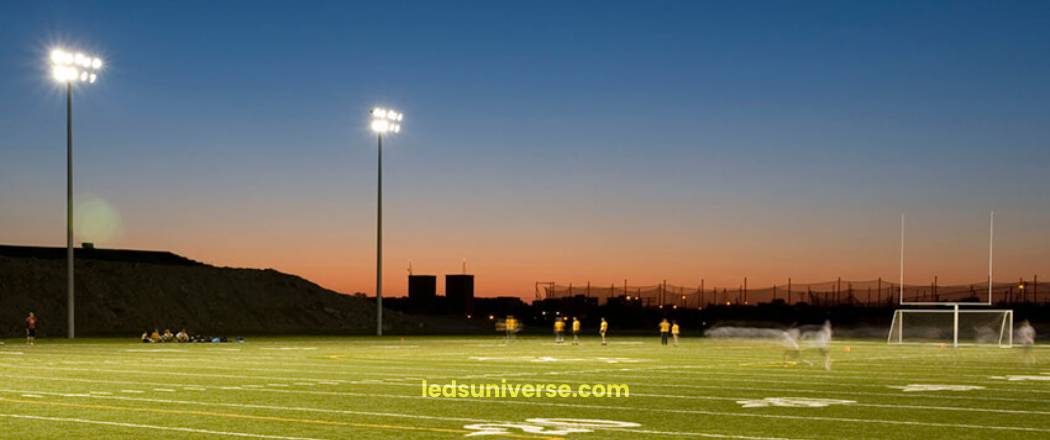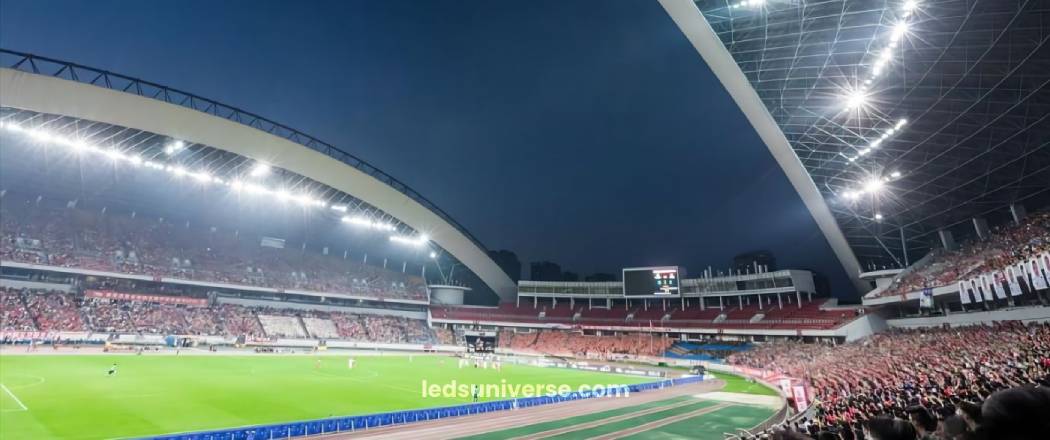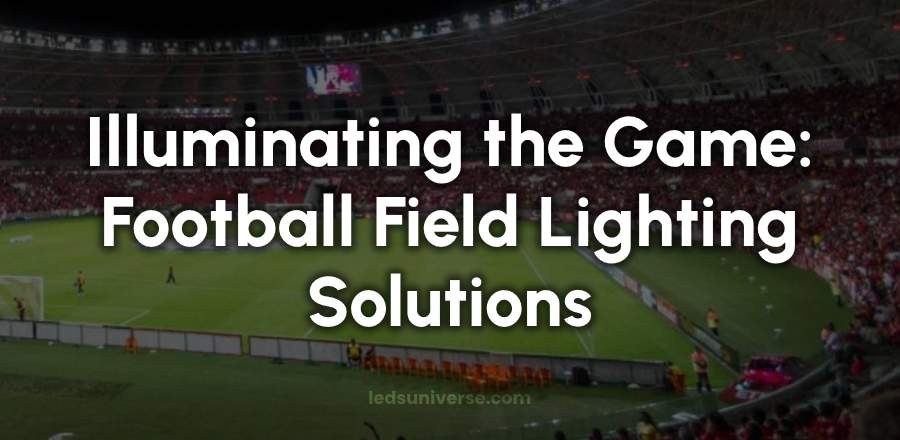Well-designed lighting solutions transform football and soccer fields into vibrant arenas, enhancing visibility for players and creating an inviting atmosphere for spectators. As communities gather under the bright lights, the energy and excitement of the game come to life, fostering connections and unforgettable experiences. With the integration of innovative technologies and sustainable practices, the future of sports field lighting promises to illuminate not just the game but also the spirit of camaraderie and passion that defines sports culture.
The ambiance and functionality of a sports field can dramatically impact the player experience and viewer engagement. With the right lighting design, football and soccer fields can extend play into the evening hours, offering flexibility for both amateur and professional athletes.
Table of Contents
ToggleUnderstanding Field Lighting Requirements
The Basics of Sports Field Lighting
When considering lighting for football and soccer fields, several fundamental aspects come into play. The primary goal is to provide uniform illumination across the playing surface, ensuring that players can see the ball and each other clearly, regardless of the time of day. Lighting must meet specific standards based on the level of play, from local leagues to international competitions.
Illumination levels are measured in lux, which quantifies light intensity. Different types of games and events demand varying lux levels. For instance, recreational games may require less intense lighting, while professional matches necessitate higher lux standards to accommodate broadcasting and spectators.
Determining Lux Levels
The level of brightness required for football and soccer fields varies according to the nature of the event. For recreational play, a lighting level of around 100 to 200 lux can suffice. However, competitive matches may require between 200 to 500 lux for amateur leagues, and up to 1000 lux or more for professional games. The layout of the field, the distance from the light sources, and the angle at which the light hits the ground all influence how effectively these levels are achieved.
Key Parameters for Effective Soccer Field Lighting Design
Brightness or Lux Level
Lux levels vary significantly between televised and non-televised tournaments. For instance, an international football field typically requires a lux level of 1200, whereas school and college pitches may only need 150 lux. Issues with achieving the correct lux level during football field lighting installations are common, so discussing your project with us will allow us to propose a solution that meets your expectations.
Uniformity Standards
Lighting uniformity is another significant parameter, measured on a scale from 0 to 1, representing the ratio of minimum illuminance to average illuminance. As lux levels increase, the uniformity ratio may decrease, indicating that achieving high uniformity may require more LED lights for overall lighting installation.
Color Temperature
The typical color temperature for a standard football field ranges from 4000K to 5500K. Various lighting designs may adjust color temperatures to enhance illumination for both players and spectators.
The Components of Field Lighting Design

Types of Lighting Fixtures
Various types of lighting fixtures are available for illuminating sports fields. Each type offers distinct advantages and can impact energy consumption, maintenance, and light quality.
Floodlights are among the most popular choices due to their ability to cast bright, wide beams of light. These fixtures are often mounted on poles situated at the corners or along the sidelines of the field, allowing for optimal coverage. High-intensity discharge (HID) lamps, such as metal halide and high-pressure sodium lamps, are common in floodlighting, as they produce bright light and have a long operational life.
In recent years, light-emitting diode (LED) technology has emerged as a leading option for sports field lighting. LEDs offer high energy efficiency, longer lifespans, and lower maintenance requirements. Their ability to be dimmed allows for greater control over light levels during different phases of a game or event. Furthermore, LEDs produce minimal heat, making them safer for players and reducing the risk of overheating.
Placement of Fixtures
The placement of lighting fixtures significantly impacts the overall effectiveness of the lighting design. Strategic positioning minimizes shadows and enhances visibility for players. Typically, fixtures are mounted on poles that are 15 to 25 meters high, depending on the specific needs of the field.
A common arrangement involves placing fixtures at each corner of the field, angled inward to provide uniform light coverage. Additional poles may be placed along the sidelines for added illumination, especially in areas that require higher visibility, such as near goals or penalty areas.
Calculating Lighting Needs
Conducting a comprehensive lighting analysis is fundamental to achieving optimal illumination. This process involves evaluating various factors, including field dimensions, fixture type, and desired lux levels. Using specialized software can aid in simulating different lighting scenarios and identifying the best configurations for achieving uniform light distribution.
Incorporating a photometric analysis allows for precise measurements of how light interacts with the playing surface. This data ensures that lighting designs meet regulatory standards and provide a safe, enjoyable environment for players and spectators alike.
Enhancing Visibility and Reducing Glare
The Importance of Glare Control
While sufficient lighting is essential, managing glare is equally vital in a well-designed lighting system. Glare can hinder visibility, making it difficult for players to see the ball and each other. To mitigate glare, designers must consider the angle of the fixtures and their placement.
By utilizing shielding techniques, such as visors or louvers, designers can redirect light and reduce the amount of stray light that reaches players’ eyes. Moreover, employing fixtures with lower lumens per watt can help in minimizing glare while still providing adequate illumination.
Color Temperature and Visibility
The color temperature of lighting fixtures also influences visibility on the field. Measured in Kelvin (K), color temperature refers to the hue of the light produced by a lamp. For sports fields, a color temperature of around 4000K to 6000K is often preferred.
This range produces a bright, white light that closely resembles natural daylight, enhancing color perception for players. When players can see the ball’s color clearly against the backdrop of the field, their ability to respond to fast-paced actions improves significantly.
Sustainable Lighting Solutions

The Role of Energy Efficiency
As awareness of environmental sustainability increases, sports organizations are looking for ways to minimize their ecological footprint. Energy-efficient lighting solutions play a crucial role in achieving these goals.
LED lighting stands out as an eco-friendly option, consuming significantly less energy compared to traditional lighting fixtures. By reducing energy consumption, facilities not only lower operational costs but also contribute to reducing greenhouse gas emissions.
Smart Lighting Technology
Advancements in smart lighting technology offer innovative ways to enhance field lighting while promoting sustainability. Smart systems can adjust lighting levels based on real-time conditions, such as the amount of natural light available or the number of players on the field.
Implementing motion sensors allows lights to dim or turn off when the field is unoccupied, further conserving energy. These systems can be programmed for different events, ensuring that the lighting is tailored to specific requirements without unnecessary energy waste.
Maintenance and Longevity
The Importance of Regular Maintenance
To ensure the longevity and effectiveness of lighting systems, regular maintenance is essential. Accumulated dirt and debris on fixtures can significantly reduce light output, diminishing visibility on the field.
Scheduled cleaning and inspections help identify any issues early on, ensuring that fixtures remain in optimal working condition. Maintaining proper alignment of fixtures is also crucial, as even slight shifts can alter light distribution and lead to uneven illumination.
Lifespan Considerations
When selecting lighting solutions, considering the lifespan of the fixtures is essential. While traditional HID lamps typically last around 10,000 to 20,000 hours, LED fixtures can last significantly longer, often exceeding 50,000 hours.
The extended lifespan of LEDs reduces the frequency of replacements, translating to lower maintenance costs and less waste over time. Investing in high-quality fixtures that provide reliable performance can ultimately lead to greater cost savings in the long run.
Regulatory Standards and Compliance
Adhering to Local Regulations
Complying with local and national regulations regarding sports field lighting is paramount. These regulations often dictate the required lux levels, fixture types, and placement strategies.
Before commencing a lighting project, consulting with relevant authorities ensures that the design adheres to all necessary guidelines. Understanding these standards helps prevent costly modifications later on and ensures a safe playing environment for athletes.
Meeting Broadcast Requirements
For fields hosting televised events, additional lighting considerations may arise. Broadcasting companies often have specific lux requirements that must be met to ensure optimal viewing conditions for audiences. Meeting these standards requires careful planning and collaboration between lighting designers, facility managers, and broadcasters.
The integration of high-quality lighting not only enhances the on-field experience for players but also ensures that viewers at home enjoy a vibrant, clear broadcast. This aspect further underscores the role of lighting in promoting the visibility and appeal of sports.
Innovations in Field Lighting
New Technologies on the Horizon
The field of sports lighting continues to evolve, with emerging technologies poised to enhance the player and spectator experience. Innovations in LED technology, such as improved color rendering and energy efficiency, promise to revolutionize how fields are illuminated.
Developments in smart lighting systems are also gaining traction, allowing for greater customization and control over field lighting. These advancements facilitate dynamic lighting scenarios that can adapt to various activities, from practice sessions to high-stakes matches.
Embracing the Full Potential of Field Lighting
Creating a Welcoming Atmosphere
Effective lighting design does more than simply illuminate a playing surface; it creates an inviting atmosphere for players and spectators. A well-lit field fosters enthusiasm and excitement, enhancing the overall experience of sporting events.
When players feel confident in their visibility, their performance is likely to improve. For spectators, a well-lit environment promotes engagement, allowing them to enjoy the action without distraction.
The Role of Community Engagement
Field lighting plays a significant role in community engagement. Well-illuminated sports fields become gathering places for families, friends, and fans. Events held in these spaces can foster a sense of community and belonging.
Communities often come together to support local teams, making the field a focal point for social interaction. As such, investing in quality lighting solutions benefits not only the players but also the surrounding community, contributing to a vibrant sports culture.
Conclusion
The design and implementation of lighting solutions for football and soccer fields are multifaceted processes that require careful consideration. From selecting appropriate fixtures to understanding lux requirements and ensuring compliance with regulations, every detail contributes to the overall success of the lighting system.
As technology continues to advance, the potential for enhanced field lighting becomes even greater. Embracing innovations and sustainable practices will lead to brighter, more welcoming sports environments that elevate the experience for players and fans alike.
